HIGHLIGHTS: NOVEMBER 22, 2024
• U.S. dairy at COP29
• U.S.-Indonesia dairy education project launches
• Sheridan elected UNEP facilitator
• U.S. cheesemakers set medal record at World Cheese Awards
• USDEC seeks dairy trade collaboration at APEC Summit
• IAG meeting greenlights 2025 program
• Regulatory workshop connects with MENA government officials
• Senate Dem farm bill features dairy trade priorities
• Harden stresses food security, healthy planet
• Forum touts dairy ingredients for sports nutrition in China
• U.S. dairy ingredient workshop targets yogurt in Brazil
• USDEC debuts at Peru ingredient trade show
• Member opportunity: Registration open for USDA Guatemala mission
• Market Summary: GDT continues rise
• Latest International Demand Analysis (September data) ready for download
• China’s imports continue to lag
• EU farmers protest Mercosur trade deal
• Senate DHS appropriations bill backs supply chain theft taskforce
• New USDEC research: Ingredient opportunities in bakery in Southeast Asia
• FrieslandCampina consolidates Dutch operations
• Valio to focus on lactose-free in Southeast Asia
• Company news: Lifeway, Danone, Pizza Hut
Featured
U.S. dairy points the way to sustainable growth, nutrition at COP29
USDEC President and CEO Krysta Harden and Dairy Management Inc. Chair Marilyn Hershey co-led the U.S. dairy delegation to this year’s UN Climate Conference (COP29) in Baku, Azerbaijan. COP is, in the words of the UN, “the world’s only multilateral decision-making forum on climate change that brings together almost every country on Earth.” Representatives from across the societal spectrum—government, business, science, civil society, agriculture—meet to share insights and best practices to strengthen global, collective, inclusive climate action.
This year’s conference, which ran from Nov. 11-22, welcomed representatives from 197 countries and the EU. It marked the fourth straight year that USDEC has been deeply involved in the global gathering and the second year that the meeting featured a dedicated agriculture thematic day.
The U.S. dairy delegation participated in more than a dozen panels and events convened with international institutions, non-governmental organizations and country representatives. USDEC hosted or co-hosted five sessions featuring key themes like promoting trade and elevating farmer voices that USDEC has made priorities at COP:
- “Productivity with Purpose: How Sustainable Intensification Can Feed More People While Protecting the Planet.”
- “Empowering Farmers: Access to Finance and Innovation for Climate Adaptation and Resilience.”
- “Road to COP30: Elevating Farmer Voices in Climate Action and NDCs and NAPs.” (USDEC’s first official UN Framework Convention on Climate Change side event)
- “Leveraging Trade for Climate-Resilient Food Systems.”
- “Investing in the Future in Sustainable Livestock Systems—Stimulating Action and Impact.”

Members of the U.S. dairy delegation in Baku (left to right): Nick Gardner, Marilyn Hershey, Krysta Harden and Kelly Sheridan.
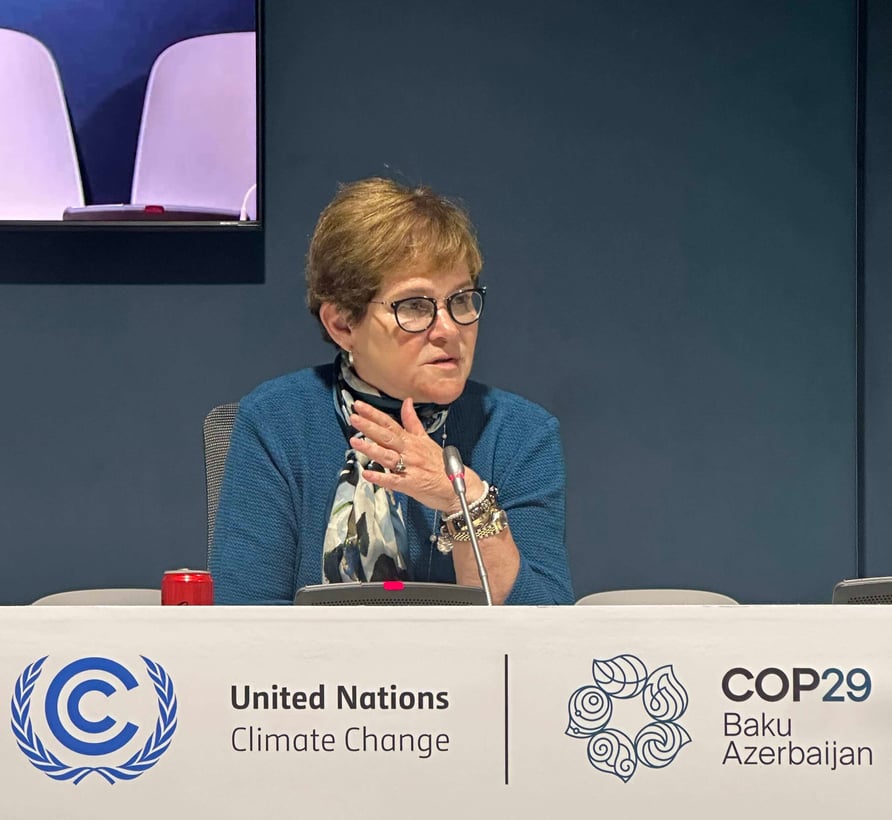
Krysta Harden at USDEC’s first official COP side event, “Empowering Farmers: Access to Finance and Innovation for Climate Adaptation and Resilience.” U.S. dairy farmers are investing in climate-smart practices, she said, but to fully transition to more resilient, productive and low-emission systems, they need to have the financial resources to cover the costs of changing practices and management systems, including government support, market-based options and access to capital.
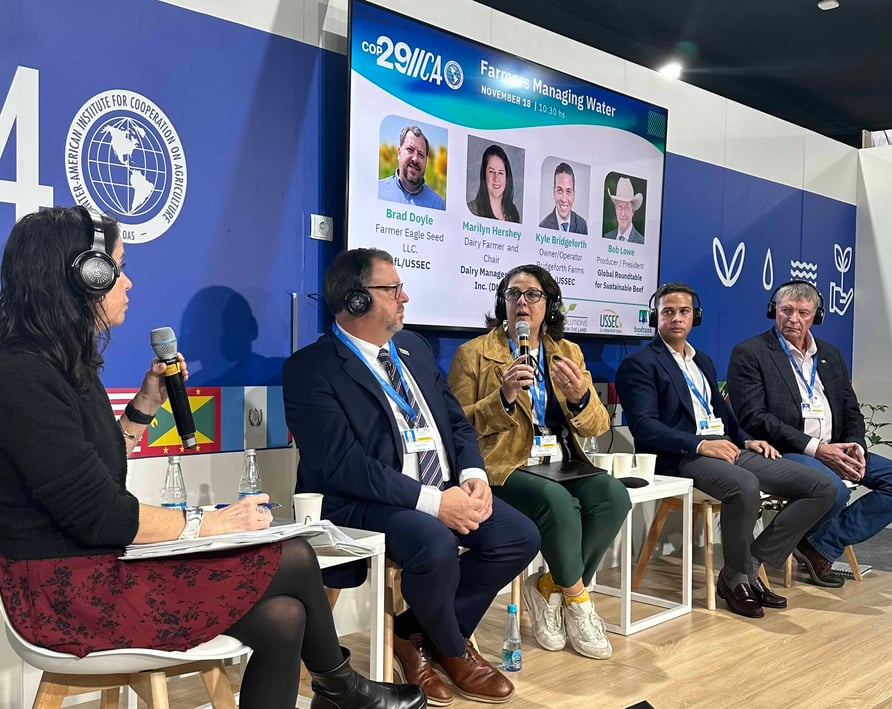
Marilyn Hershey (center) highlights measures her farm has taken to increase water efficiency and improve water quality during the session, “No Water, No Food Security: Dialogues for Climate Action.”
USDEC’s ongoing goal with engagements like this is to present U.S. dairy exports as a global food systems solution, showcasing how U.S. dairy can nourish the world while reducing emissions, increasing water efficiency and improving water quality. COP provides a platform to strengthen partnerships that help drive greenhouse gas reductions by fostering collaboration across government, academia, business and civil society.
With U.S. dairy farmers among the delegation, USDEC also seeks to ensure that farmers voices are part of the global climate conversation and the recommendations that may issue from the conference support overall objectives.
“USDEC is part of this COP process to ensure that global action and policies incorporate U.S. dairy producers’ experiences and contributions,” said Harden in a USDEC press release on the conference. “We believe that sharing the U.S. experience and the success our farmers and processors have achieved to date—and the ambitious projects we continue to pursue—will help accelerate the delivery of sustainable livestock systems in the Americas and globally.”
For additional images from COP29, follow the USDEC X feed.
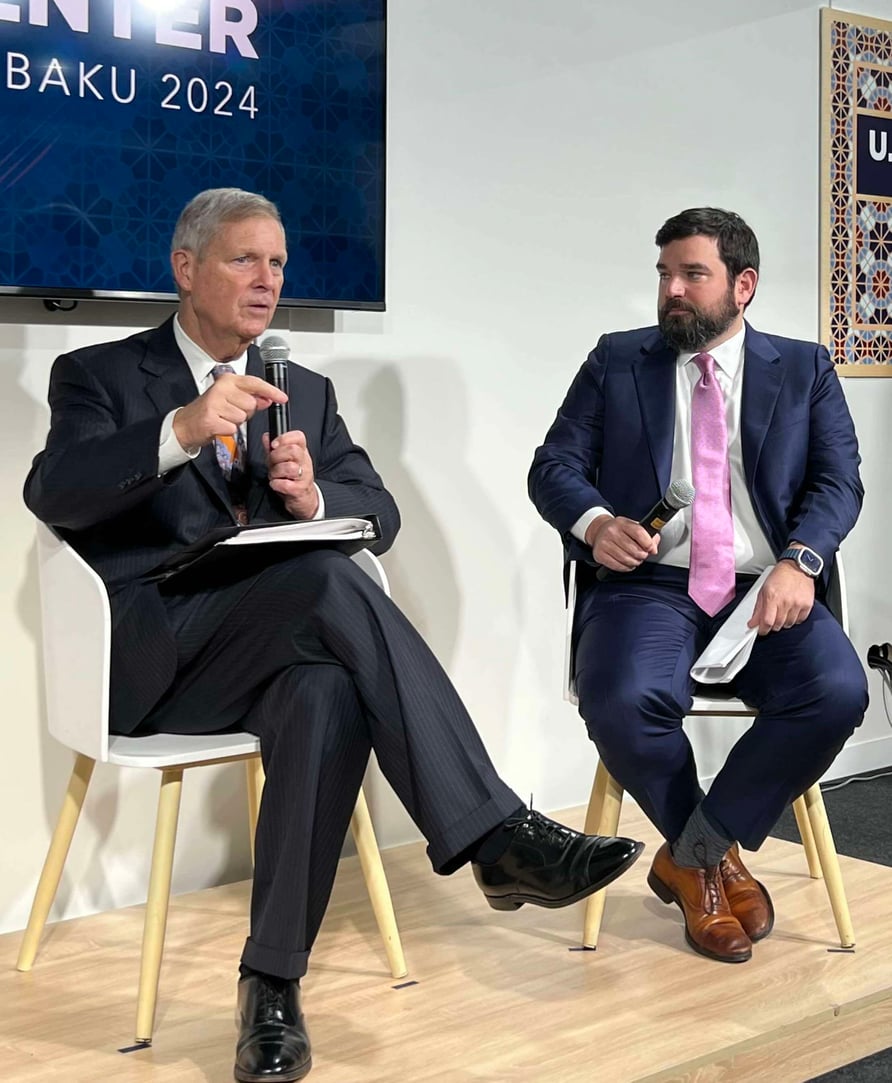
USDA Secretary Tom Vilsack explains that the best way to combat the impacts of climate change is to equip producers of all sizes with the tools they need to adapt and build resistance. Vilsack spoke at the side event, “Building Rural Economies and Markets through Partnerships for Climate-Smart Agriculture and Forestry,” moderated by USDEC’s Nick Gardner.
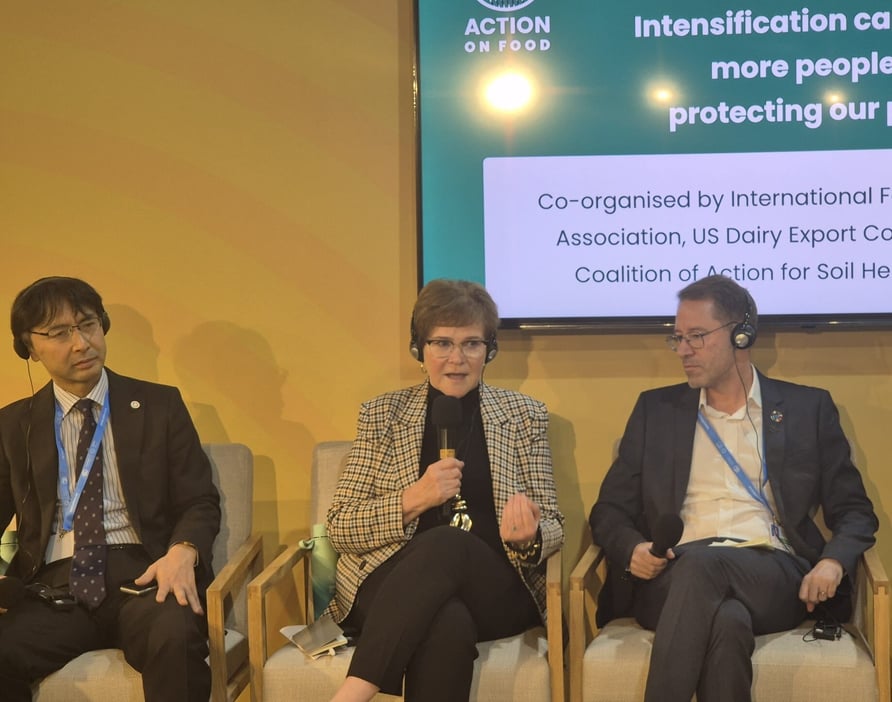
Krysta Harden (center) explains how U.S. dairy farmers can achieve what USDA calls “sustainable productivity growth” (i.e., producing more milk using fewer resources) during the side event, “Productivity with Purpose: How Sustainable Intensification Can Feed More People While Protecting the Planet.” Efficiency and environmental stewardship are key, focusing on innovations in animal genetics, ration optimization, animal care practices, on-farm technology, and better resource use.
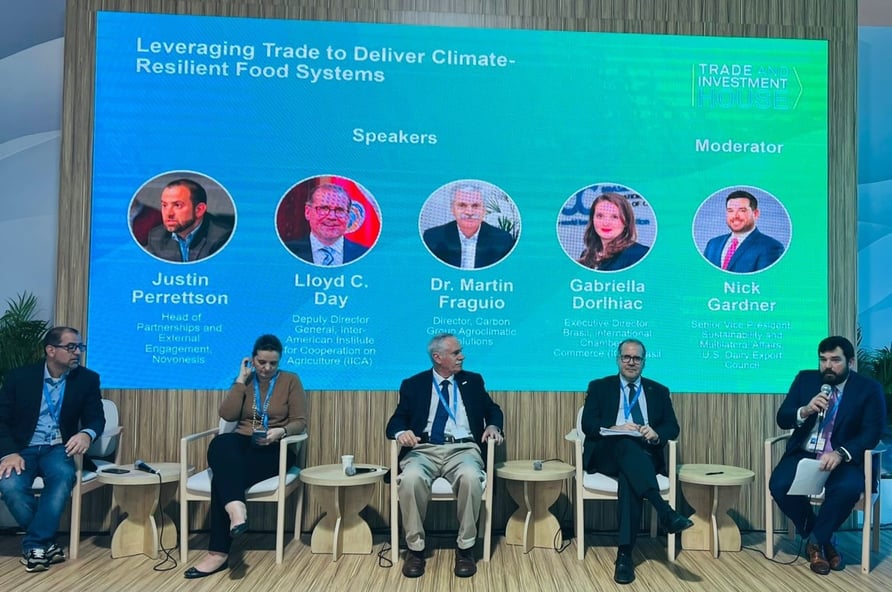
Nick Gardner (far right) moderates a panel highlighting the critical role of trade in achieving global environmental, food system and nutritional goals.
U.S., Indonesia officially launch dairy farmer education project
The United States and Indonesia publicly announced the launch of the U.S.-Indonesia Dairy Partnership Education Project this week in Jakarta. The project, a joint effort between USDEC, New Mexico State Department of Agriculture (NMDA), New Mexico State University, and their Indonesian partners Global Dairy Alami, Cimory and Ultrajaya, has been in the works for more than a year. As part of USDEC’s broader educational and outreach work with Indonesia related to this project, USDEC also collaborated with the Wisconsin Department of Agriculture and the National Associations of Departments of Agriculture on a reverse trade mission to Wisconsin last month (see Global Dairy eBrief, 10/4/24).
USDEC’s Shawna Morris, executive vice president, Trade Policy and Global Affairs, and Jonathan Gardner, senior vice president, Market Access and Regulatory Affairs (MARA), have made several visits to the country to work out details and meet with stakeholders in the Indonesian government and private sector before leading this week’s U.S. dairy delegation to Indonesia for the official roll-out and a series of meetings with government officials and other institutions. Aimee Pinkerton, manager, MARA, as well as Arief Rashidi, USDEC’s country manager for Indonesia, and Su Yong Lee of USDEC’s Southeast Asia office also joined the delegation, together with representatives from New Mexico.
The project is designed to educate small and medium-scale Indonesian dairy farmers on various best practices for growing milk production and improving quality. The project aims to support the success of the Indonesian government’s Free Nutritious Meals program and the incorporation of school milk in that program as a key element contributing to children’s growth and overall health. (Click here to watch a short video outlining the program.)
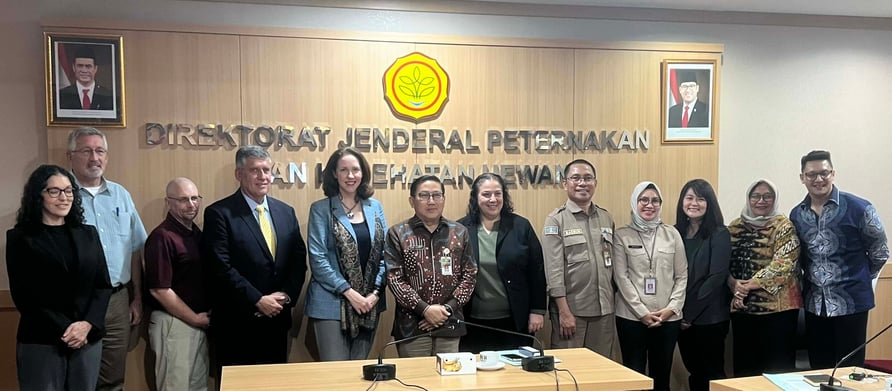
The U.S. delegation with leaders of the Ministry of Agriculture’s Directorate General of Livestock and Animal Health Services.
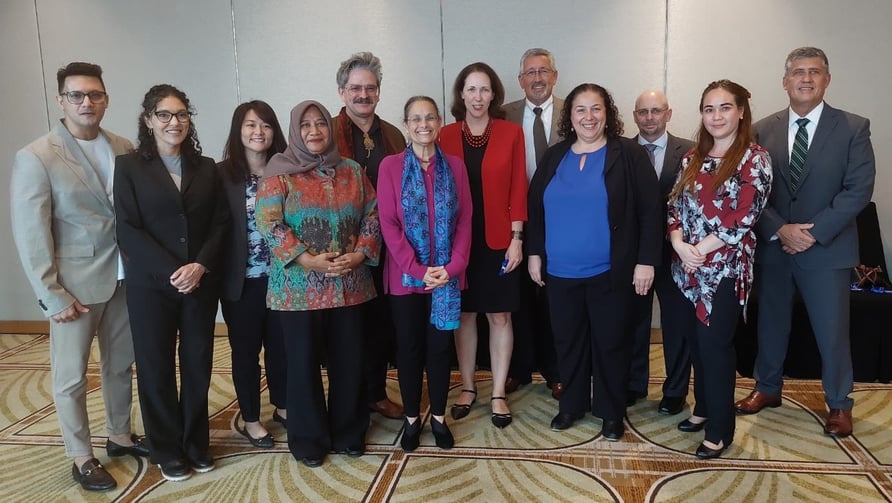
USDEC hosted the project’s launch event and a subsequent an afternoon networking reception Nov. 21 featuring distinguished speakers such as U.S. Ambassador Kamala Shirin Lakhdhir (blue scarf) to celebrate the new project.
The project has four elements:
- Farm management, including administrating farm operations (from budgeting and personnel to infrastructure and sanitation), animal welfare, and ongoing training.
- Dairy animal nutrition, including feed management and trends, nutrition practices and reducing caloric stress.
- Improving quality and increasing yields, including herd and pasture techniques, adaptation practices, and weather management.
- Animal health, including treatment of diseases, vaccines and animal hygiene.
USDEC and the project’s partners plan to implement a series of dairy farming training courses delivered through a combination of in-person and virtual instruction. The first in-person training is slated to start in early January 2025. A virtual curriculum of short, topic-specific videos has been developed to enable a wider set of farmers to access the training materials. USDEC and NMDA will assess the effectiveness of the virtual curriculum and modify or supplement as needed after the first year of implementation.
“The U.S.-Indonesia Education Project is a proof of a strong partnership between our two countries, which is based on a joint commitment to innovation and sustainability,” said U.S. Ambassador Kamala Shirin Lakhdhir. “By equipping Indonesian dairy farmers with knowledge and equipment, this initiative not only strengthens the agricultural sector but also contributes to improving the health and well-being of children through better nutrition programs. It is an honor to witness this collaboration, which shows how shared expertise can drive meaningful change.”
In addition to the education program launch, the partners also aim to promote the vital role milk plays in fostering optimal child development and health outcomes—and the value of the school meal program to provide that nutrition. Local production will be an important part of the school meals program yet is expected to only account for 30% of its milk needs in the coming years. USDEC is working to position the U.S. as a preferred partner of choice for the complementary milk powder that will also be needed to meet the school meal program’s demand volumes.
To that end, while in Jakarta this week USDEC also met with a number of government officials and private sector entities including: the Ministry of Agriculture’s Director General for Livestock and Animal Health Services, the Minister of Religious Affairs (overseeing Muslim schools across the country), the Vice Minister of Trade, the National Nutrition Agency (vested with implementing the school meals program), BPJPH (Indonesia’s halal certification overseeing authority), the Vice Chair of the Indonesian Chamber of Commerce and leaders from Padjadjaran University.
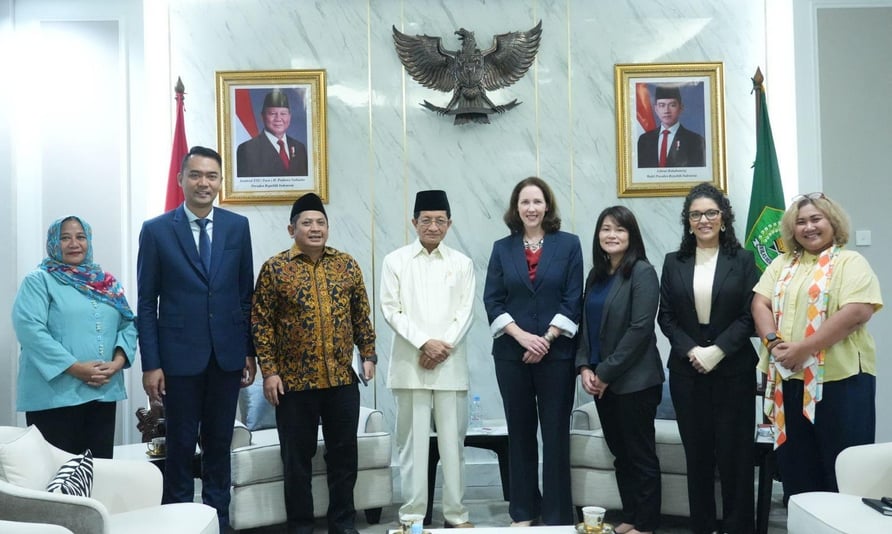
Some members of the USDEC delegation with the leaders of Indonesia’s Ministry of Religious Affairs, which operates many of the schools in the country.
Sheridan’s election as UNEP regional co-facilitator enhances U.S. dairy presence at global policy-setting organization
U.S. dairy further increased its profile within the UN Environment Programme (UNEP) this week with the election of USDEC Vice President, Environmental Affairs, Kelly Sheridan, as a “North America regional co-facilitator.” UNEP accredited organizations elect two facilitators per region to ensure major groups and stakeholders’ regional views are presented to the UN Environmental Assembly (UNEA) and its subsidiary organs (as well as in other meetings that may be convened).
Sheridan’s election is a testament to USDEC’s hard work and well-earned reputation among UN agencies as a leader in sustainable food systems policy. UNEP first granted USDEC official UNEP “observer status” in 2022, allowing the organization to formally participate in UNEP policymaking process, advocate directly for U.S. dairy’s role in sustainable food systems, and promote U.S. dairy as an environmental solution. Sheridan’s elevated role will increase the impact of USDEC’s engagement at UNEP and further these objectives.
UNEP has been setting the global environmental agenda and promoting the coherent implementation of UN environmental policies since its inception in 1972. It is currently working on several issues that could have ramifications on U.S. dairy production and trade, including a plastics waste reduction treaty and agricultural biodiversity policies.
Sheridan’s term runs until Nov. 19, 2026.
U.S. cheesemakers set medal record at 2024 World Cheese Awards
U.S. cheesemakers earned a record 160 medals at the 2024 World Cheese Awards (WCA) held in Viseu, Portugal. The United States brought home eight Super Gold medals, 23 Gold, 49 Silver and 80 Bronze. Each of those tallies topped the previous year when the U.S. set a record with 147 total medals.
USDEC was a main sponsor of this respected cheese competition, which brought together cheesemakers, retailers, buyers and food commentators worldwide to judge 4,786 cheeses from 47 countries. USDEC sponsored the entry fees for 246 cheeses from 44 U.S. companies. USDEC members won 38 medals.
Vermont-based Cellars at Jasper Hill brought home the “Best American Cheese” trophy for its Bayley Hazen Blue, which also qualified as one of the 14 finalists for best overall cheese in the world. Other U.S. Super Gold winners for cow’s milk cheeses included Von Trapp Farmstead’s Mt. Alice and Mad River Blue, Marieke Gouda’s Marieke Gouda Reserve, Parish Hill Creamery’s Jack’s Blue, and Tulip Tree Creamery’s Nightshade.
“Participation in contests such as the WCA helps demonstrate the fact that the U.S. is a producer of high-quality, award-winning cheeses that can compete and win on the global stage against European counterparts,” says Ryan Hopkin, USDEC director, Cheese Marketing Communications. “As our medal total continues to grow year by year, we not only add to the U.S. reputation as a top-tier cheese supplier but also enhance the global image of the U.S. dairy industry as a whole.”
USDEC continues trade collaboration efforts at APEC summit
USDEC’s Jaime Castaneda participated in the Asia-Pacific Economic Cooperation (APEC) CEO Summitt in Lima, Peru, last week. The mission was part of broader USDEC efforts to enhance trade collaboration across APEC member economies. USDEC is focusing on possible projects that could be part of APEC’s technical work on sustainability and health certificates. The U.S. dairy sector’s ongoing involvement with the group emphasizes the importance of trade facilitation for the U.S. industry in the Pacific region.
President Joe Biden, Chinese President Xi Jinping, and other national leaders and dignitaries participated in and spoke at the event. USDEC met with various delegations to discuss relevant dairy and trade issues. In particular, Castaneda connected with Indonesian representatives as part of USDEC’s work to enhance the two countries’ dairy relationship (see article above on the U.S.-Indonesia Dairy Farmer Partnership Education Project).
In addition to the meetings, Castaneda spoke with international media and other delegations, focusing on the commitment of U.S. dairy farmers and manufacturers to continue to be reliable dairy suppliers across the region.
One interesting sidenote was the large contingent of Chinese business people and government officials due to the opening of the deepwater Port of Chancay. President Xi and Peruvian President Dina Boluarte inaugurated the port ahead of the Summit. China invested $1.3 billion in the mega-project, with the aim of increasing trade with South America.
IAG gives the nod to USDEC ingredient plans for 2025
USDEC’s Ingredients Advisory Group met Nov. 13 in Chicago to review key ingredient marketing program achievements from 2024 as well as gain member feedback and input on proposed 2025 ingredient marketing activities around the world. Nineteen representatives from 16 USDEC member companies attended.
Participating IAG members affirmed alignment with and support of staff proposals for activities in China, Mexico, Central America and the Dominican Republic, South America, Southeast Asia, Vietnam, Japan, Korea, Taiwan, the Middle East and Africa. This included potential funding from the second tranche of the Regional Agricultural Promotion Program (RAPP), although these activities remain unconfirmed given the uncertain status of RAPP allocations. USDEC will continue to share updated information regularly via the monthly activity calendar announcement, the Marketing Events section of the USDEC website and the weekly Global Dairy eBrief newsletter.
During the IAG meeting, special guest speaker Martin Teo, senior director, food applications and innovation for USDEC Southeast Asia, provided a deep dive into USDEC activities and initiatives at the U.S. Center for Dairy Excellence (U.S. CDE) that aim to inspire usage and innovation with U.S. dairy ingredients. U.S. CDE Executive Director and USDEC Senior Vice President, Global Ingredients Marketing, Vikki Nicholson-West further reminded IAG members that the U.S. CDE is not just for USDEC activities but is also a resource for USDEC member use. Nicholson-West also shared further ideas and details for how members can make the most of the facility and reserve space through the online booking tool as was previously shared in the July 26 issue of Global Dairy eBrief.
USDEC expects to hold the next IAG meeting on April 9, 2025, in conjunction with the annual membership meeting. For more information about the IAG meeting or the U.S. CDE, please contact Vikki Nicholson-West at vnicholson-west@usdec.org.
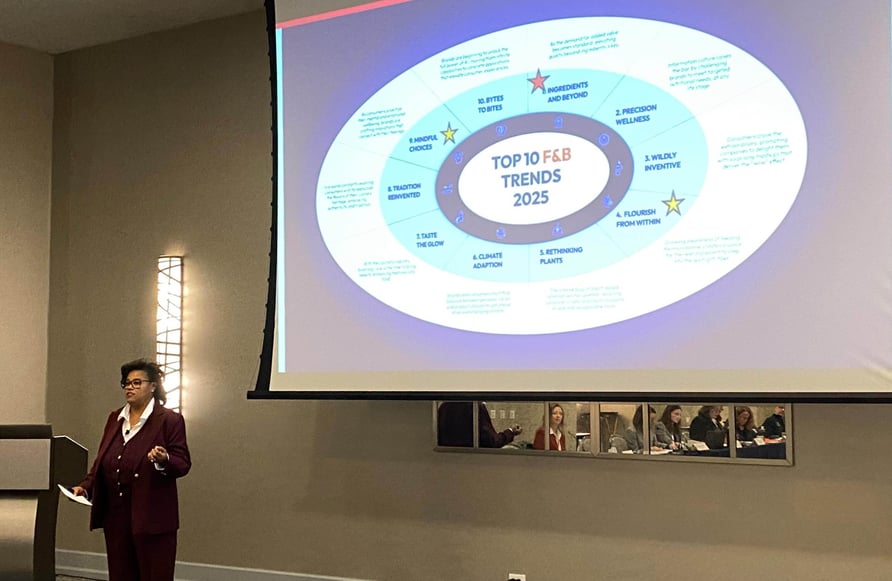
Vikki Nicholson-West shares Innova Market Insights’ recently released top 10 food and beverage trends for the coming year, setting the stage for the 2025 marketing landscape. Trend No. 1 is “Ingredients and Beyond,” reinforcing that elevating the quality story of ingredients will be key to differentiating products from competitors—and ultimately winning consumers. Protein exemplifies this trend.
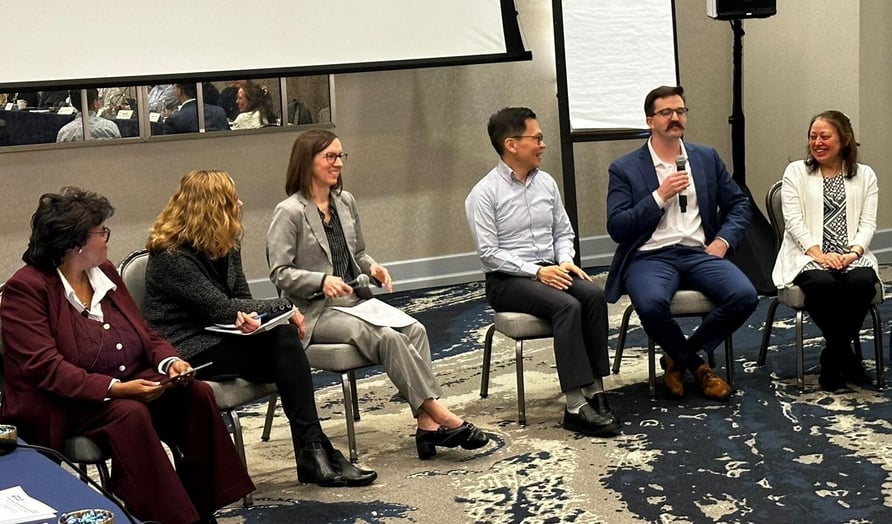
USDEC’s Ingredients Marketing team and USDEC Southeast Asia’s Martin Teo (third from right) participate in a panel discussion on USDEC ingredient marketing approaches and initiatives aimed at spurring innovation with U.S. dairy ingredients and spurring members’ success.
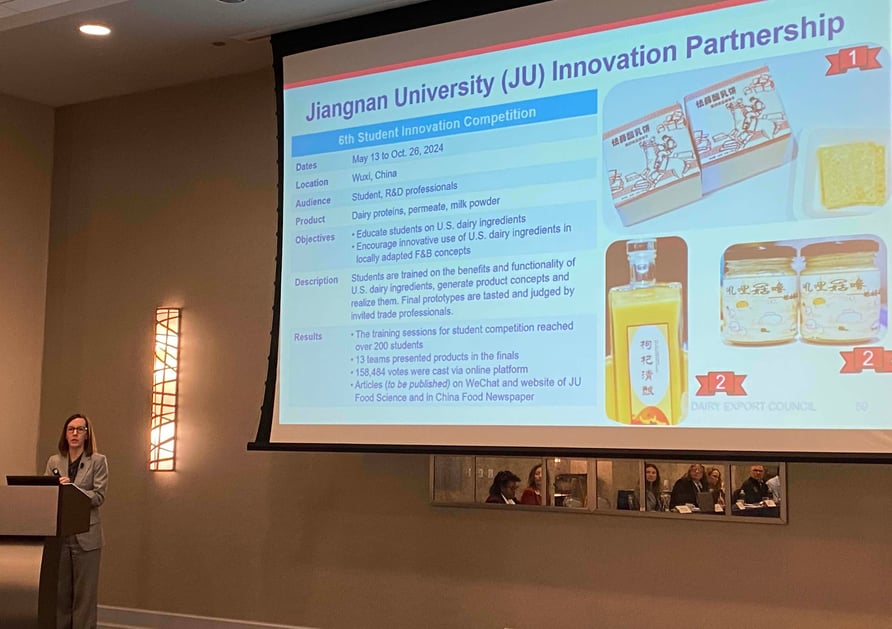
Annie Bienvenue shares results from USDEC’s successful student innovation competition in China, held in partnership with Jiangnan University (see Global Dairy eBrief, 11/15/24).
U.S. dairy regulatory workshop engages government officials from across Middle East
Last week in Oman, USDEC held its second multi-national government seminar for the Middle East and North Africa (MENA) region, titled The USDEC Middle East & North Africa Workshop on U.S. Dairy Regulatory Systems. The seminar brought together officials from more than 11 MENA countries to foster strong relationships and facilitate open dialogue on issues related to food safety, standards and market access.
The meeting drew a larger-than-expected crowd of 138 attendees and the audience remained highly involved throughout the two days. By engaging with key decision-makers from across the region, the seminar aimed to:
- Enhance market access: Address market access challenges and regulatory barriers to ensure smooth trade flows for U.S. agricultural products.
- Promote U.S. food safety and standards: Educate MENA officials on U.S. food safety and quality standards, encouraging the adoption of international best practices.
- Anticipate and address regulatory shifts: Proactively identify and address potential regulatory issues.
Through this recurring event, USDEC seeks to create a platform for constructive dialogue, knowledge sharing, and collaboration, ultimately benefiting both the U.S. and MENA economies.
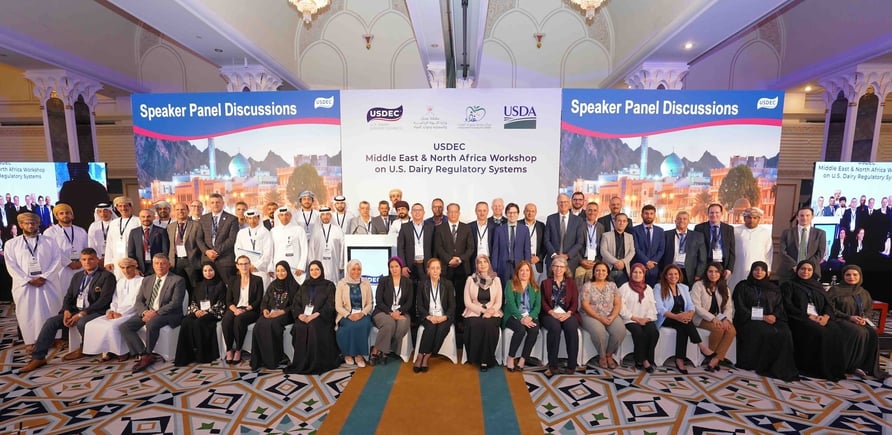
A portion of MENA government officials, USDEC staff and guest speakers pause for a group photo during the USDEC workshop on U.S. dairy regulatory systems last week in Oman.
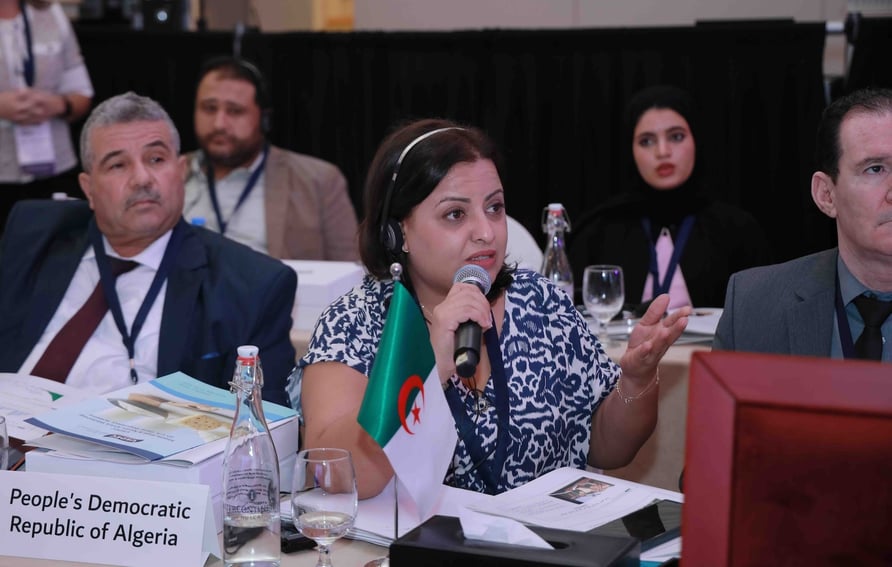
Audience members peppered speakers with questions throughout the two-day workshop, interested to learn more about U.S. dairy regulatory standards and processes.
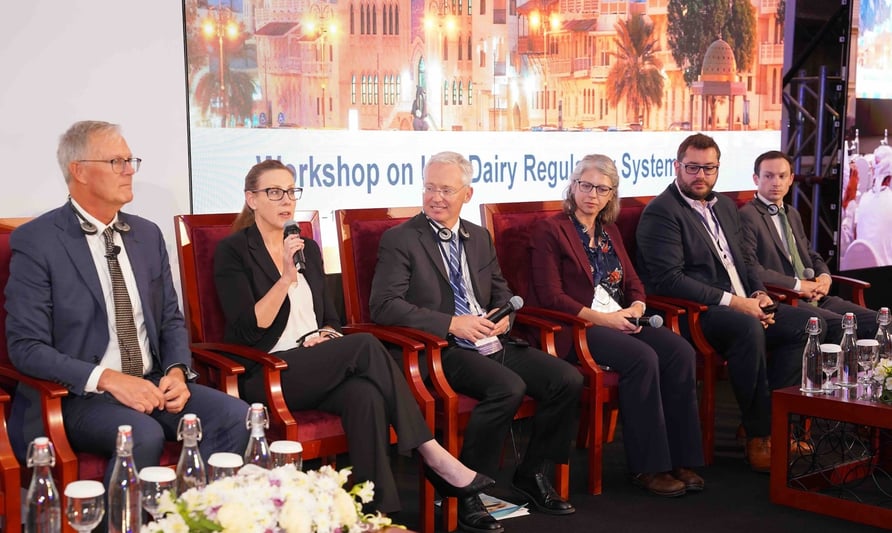
A Q&A panel was designed to field any U.S. dairy question the audience might ask. Left to right: William Francis, senior policy advisor, Agricultural Marketing Service, Dairy Program; Becky Nyman, California dairy farmer and USDEC vice chair; David Hakes, senior director of Scientific & Regulatory Affairs, Dairy Farmers of America; Megan Schmid, assistant director, Cattle Health Center, Animal and Plant Health Inspection Service–Veterinary Services; Luke Waring, USDEC vice president, Membership Programs and Strategy; and Stephen Cain, senior director, Economic Research and Analysis.
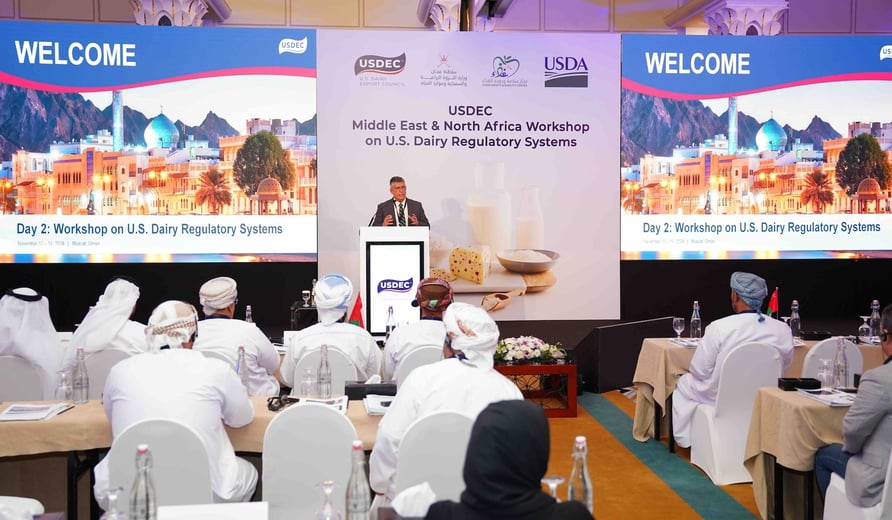
USDEC’s Jonathan Gardner expresses the U.S. dairy industry’s desire to work together with MENA governments to resolve any questions about U.S. regulatory processes and quality standards.
Key dairy export priorities present in Senate Democratic farm bill
The Senate Democratic farm bill introduced this week captured some key U.S. dairy trade priorities that USDEC supports and. Similar to the House version that cleared committee in May (see Global Dairy eBrief, 5/31/24), it includes:
- It includes the Safeguarding American Value-added Exports (SAVE) Act—a landmark bipartisan measure to protect American producers’ ability to use common names globally.
- It increases funding for the Foreign Market Development (FMD) and Market Access Program (MAP) programs—two key sources of USDEC funding for in-market programming around the world. The bill maintains current funding levels through 2027, then doubling spending in 2028 and 2029.
- It creates positive international food aid flexibilities. It Introduces new language stating that it is the policy of the United States to use agricultural commodities under the Food for Peace Act to combat child wasting and its causes. It provides the latitude for USDA to increase commodity purchases. And it adds “specialized nutrition products” to the definition of “agricultural commodity” to recognize products like ready-to-use therapeutic foods (RUTF) that contain milk powders.
USDEC was closely involved in shaping the SAVE Act, has been a long-time proponent of increases in MAP and FMD funding, and worked to build such flexibilities into international food aid programs.

USDEC's Tony Rice, director, Trade Policy, spoke Wednesday on a U.S. Agricultural Export Development Council panel to outline the dairy provisions and answer questions on the Senate and House versions of the farm bill, including the sections dealing with U.S. Export Priorities.
Harden speaks at alma mater, advocating food security and a healthy planet
USDEC President and CEO Krysta Harden had the honor this past week of delivering the keynote address at the D.W. Brooks Lecture and Awards, an annual event hosted by the College of Agricultural and Environmental Sciences at the University of Georgia.
This event provided her a chance to express appreciation to her alma mater, as the values she learned at UGA have been a guiding influence throughout her career.
It also served as an opportunity to highlight the role of U.S. agriculture in addressing global food needs.
Harden specifically emphasized the contribution of U.S. dairy exports in providing nutritious, sustainably produced foods to meet the growing global demand for high-quality protein. The world is seeking nourishment that benefits both people and the planet.
However, some regions, particularly in Sub-Saharan Africa and Asia, are currently facing challenges in feeding their populations. Many countries lack the resources to meet the rising demand for food, especially dairy. By 2050, the world will need to feed an additional 1.6 billion people.
“We cannot rest while so many people remain hungry in a world with abundant resources,” Harden said.
Harden urged businesses, farmers, government bodies, and environmental groups to collaborate in ensuring worldwide access to nutritious, sustainably produced food.
Chinese forum touts the benefits of U.S. dairy ingredients in sports nutrition
On Nov. 3, more than 100 food industry professionals and academia attended a half-day forum in China focused on U.S. dairy protein and permeate in sports nutrition. USDEC worked with Beijing Competitor Sports Science and Technology to organize the event, which was held in conjunction with the Chinese Institute of Food Science and Technology (CIFST) Annual Conference.
The forum, which took place in the city of Chongqing, showcased the benefits that U.S. dairy ingredients offer to athletes and people with active lifestyles. USDEC invited Professor Peng Zhou from Jiangnan University and Professor Cuiqing Chang, director, Research Division of Sports Nutrition, Institute of Sports Medicine, Peking University, to share their research with the audience. Both speakers emphasized the nutritional benefits and applications of dairy proteins in sports nutrition foods and beverages and shared their expertise on the advantages of dairy permeate in rehydration beverages.
The sports nutrition market in China continues to grow rapidly, posting a CAGR of 40% in the past five years. Forecasts suggest total market value could reach $3.8 billion in 2028. The top three product categories are protein powders, sports beverages and energy bars.
“Non-U.S. suppliers are actively promoting dairy ingredients like milkfat globule membrane (MFGM) and beta-lactoglobulin (BLG) in common foods, including sports nutrition. Nestlé is entering the protein market in China with its renovation of a former cosmetic plant in Taizhou,” says Annie Bienvenue. “USDEC will continue to engage in opportunities to showcase U.S. dairy frequently in China in order to maximize sports nutrition opportunities and support our members’ endeavors in the market.”
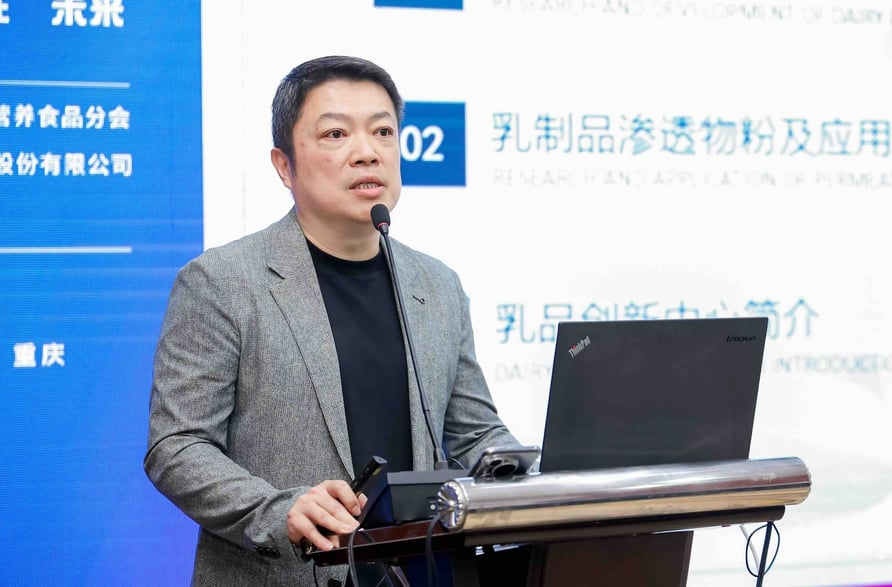
Professor Peng Zhou, representing USDEC partner Jiangnan University, highlights the nutritional benefits of dairy proteins and dairy permeate in sports nutrition foods and beverages.
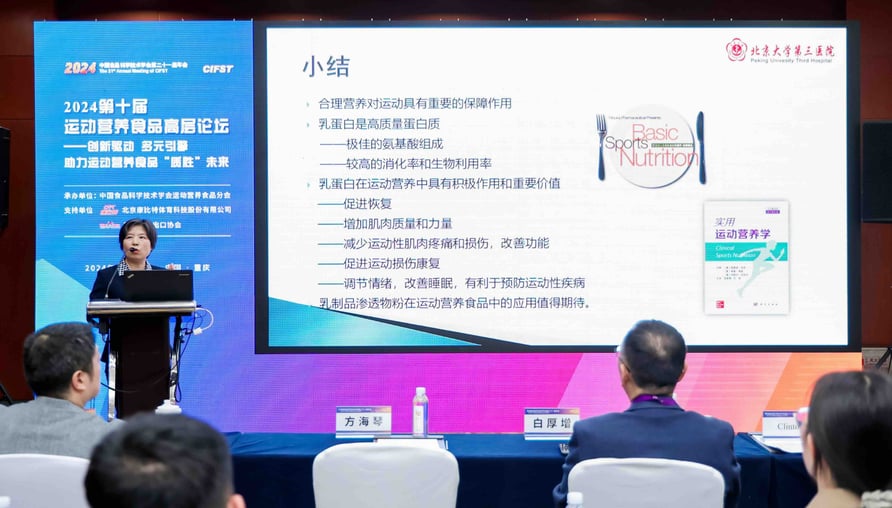
Professor Cuiqing Chang shares the advantages of dairy proteins in sports nutrition.

The audience was engaged and attentive throughout the half-day forum.
Brazilian food industry professionals explore dairy ingredient formulation benefits
On Nov. 8, USDEC sponsored a theoretical and practical course on yogurt and fermented dairy beverage manufacturing held in Campinas, Brazil. The event, hosted by USDEC educational partner the Food Technology Institute (ITAL), featured a blend of expert-led lectures and hands-on activities. Around 20 food industry professionals attended the course, covering a diverse set of expertise, which led to lively discussions. The dual nature of the course gave participants the chance to learn about and directly engage in the production of different yogurt and yogurt beverage varieties made with dairy ingredients, including dairy proteins.
The program included a presentation by Clarice Nagata from USDEC’s South America office. Nagata introduced USDEC and explained U.S. dairy’s commitment to the region and to the mutual success of Brazilian food processors who use U.S. dairy ingredients.
The program included a presentation by Clarice Nagata from USDEC’s South America office. Nagata introduced USDEC and explained U.S. dairy’s commitment to the region and to the mutual success of Brazilian food processors who use U.S. dairy ingredients.
The event also served as a valuable opportunity to connect with participants through networking-focused portions of the agenda.
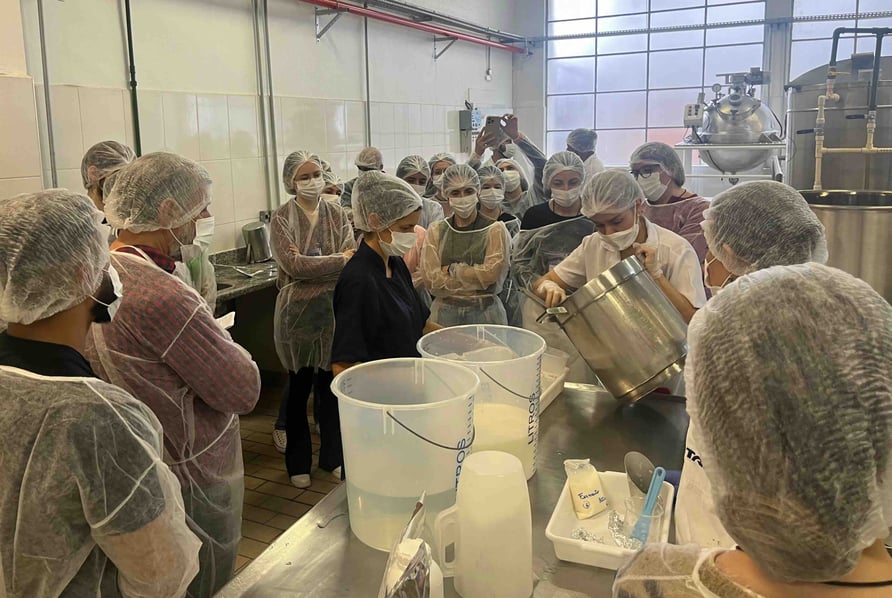
Brazilian food professionals are walked through the yogurt-making process by ITAL instructors.
USDEC strengthens Peru ties at Expo FoodTech Ingredients
USDEC gathered insights, established relationships and gained a better understanding of local demand for U.S. dairy ingredients at last week’s Expo FoodTech Ingredients in Lima. It was the first time USDEC operated a booth at the show and it provided a valuable touchpoint with Peruvian food ingredient sector to highlight opportunities with U.S. dairy ingredients.
At the show, USDEC worked with Professor John Jairo Ortiz from the Universidad de Antioquia, who collaborates with USDEC as a trainer in South American ingredient workshops (see Global Dairy eBrief 11/8/24 for the most recent). Jairo Ortiz presented at the conference portion of the event, providing an introduction to dairy ingredient composition, functionality and formulation advantages, and he continued to engage with attendees and address questions at the USDEC booth.
Key local dairy processors, importers and distributors stopped at the USDEC booth, providing further chance to connect and gain insights into opportunities with U.S. dairy. USDEC members attending on their own also made an appearance. Overall, engagement and interest in U.S. dairy ingredients were strong, despite floor traffic being negatively affected by the concurrent timing of the APEC summit, strikes, and a voluntary holiday declared during the show.
Editor’s Note: No issue next week
There will be no Global Dairy eBrief next week due to the Thanksgiving holiday. The next issue will be published Dec. 6. Happy Thanksgiving!
Events
USDA taking applications for ag trade mission to Guatemala
Registration is open for USDA’s agricultural trade mission to Guatemala on March 3-7, 2025. The deadline to apply is Dec. 3.
The mission will provide participants with the opportunity to meet directly with buyers from Guatemala, Honduras and El Salvador through tailored business-to-business meetings. Foreign Agricultural Service (FAS) staff and regional experts will lead market briefings, site visits and networking events.
U.S. dairy exports to Central America rose for four straight years through 2023 and were up another 8% through the first three quarters of 2025. Guatemala is the sixth largest U.S. cheese market in the world and it is growing rapidly. The region offers several positives for U.S. suppliers, including the Central America-Dominican Republic Free Trade Agreement, proximity to the U.S., and strong logistics, distribution, processing and cold chain management.
For more information, including a link to apply for the mission, click here.
Market Summary
USDEC’s latest International Demand Analysis finds global dairy trade flat over August-September
A 1.8% increase in global dairy trade (milk solids equivalent or MSE) in September almost completely offset the 1.9% decline posted in August, holding total volume relatively steady over the two months, according to USDEC’s latest International Demand Analysis.
Ongoing weakness in Chinese demand (year-over-year (YOY) import volume fell 11% in August and September, -28,748 MT) continues to offset gains to the rest of the world (+2%, +27,766 MT, over the same period). Mexico and Southeast Asia drove the increase to the rest of the world. YOY shipments to Mexico jumped 16% and MSE volume rose 6%.
Moving forward, USDEC expects Mexico to remain an active buyer despite a weakening currency, and Southeast Asia’s steady recovery should continue. In addition, developing markets, like Sub-Saharan Africa, are beginning to show real improvement.
For more on August and September results, download the International Demand Analysis. The report is packed with charts, graphs and commentary, providing members with a forward-looking glimpse at world markets from a U.S. exporter’s point of view. It analyzes demand in the key markets for cheese, NFDM/SMP, whey (HS Code 0404.10) and WPC80+ and also includes shorter summaries for lactose, butterfat and WMP. For questions and comments, please reach out to William Loux (wloux@usdec.org) or Stephen Cain (scain@nmpf.org).
GDT remains on a roll
Backed by North Asia (China), the Global Dairy Trade (GDT) Price Index rose 1.9% at the Nov. 19 auction. It was the seventh increase in the last nine events.
North Asia (China) again led all buyers, taking 55% of the volume—the highest percentage for some months. For the second straight auction it purchased the most WMP, SMP, butter and AMF, with demand buoyed by reduced domestic milk powder stocks, declining domestic milk production and tentative movement toward increased domestic consumption. While none of those factors have been strong enough to spark growth in China’s overall import demand (see story below), they have been driving GDT prices.
WMP increased 3.2% to US$3,826/MT. SMP rose 0.9% to US$2,882/MT. Butter ticked up 0.5% to US$7,008/MT. AMF set a new record high of US$7,622/MT, a 1.0% lift from the previous auction (also a record price at the time).
Southeast Asia buying also ticked up this week. The region led cheddar purchasing and placed second in milk powders and AMF.
The Middle East, however, took a significant step back, taking only 12% of volume—a sizable decline from 17% at the previous auction and from 23% at the same auction last year.
NZ milk output continues to grow
The price gains came despite expectations for a solid increase in New Zealand’s peak milk output. Those expectations became official when October production was announced the same day as the auction. Year-over-year (YOY) New Zealand milk production increased 2.8% for the month; milk solids volume rose 2.1%.
Year-to-date (YTD) New Zealand output through the first five months of the 2024/25 season was up 4.1%. And while monthly increases are expected to continue, the size of the YOY gains is weakening. In addition, there remains concern about milk supply in the EU, U.S. and South America.
No improvement in Chinese dairy imports in October
China’s tightening domestic dairy supply has yet to show up in import demand. YOY October volume (major products, not including fluid) fell 11% (-14,664 MT), with whey and butter the only categories to register meaningful gains.
Chinese low-protein whey imports rose 5% (+2,479 MT), making the 1% decline in September seem like a blip. Over the five months through October, Chinese whey volume was up 10% (+25,240 MT). Due to the slow start to the year, YTD volume is still down 3% (-18,739 MT), but that shortfall continues to improve.
WPC80+ is on an even bigger roll. YOY September volume jumped 26% (+688 MT), marking the fourth straight double-digit gain. YTD volume was up 9% (+3,071 MT).
But import demand remains slow for most other products, SMP in particular. For the second straight month, Chinese SMP imports plunged more than 50%. At 10,414 MT, October volume would have been the lowest monthly volume in eight years—if it weren’t for September 2024’s 9,414 MT.
YOY cheese imports dropped 12% (-1,393 MT). It was a disappointing turn after a 6% gain in September (coupled with economic stimulus) kindled hopes that consumption might be rebounding. A sharp drop in U.S. cheese imports were the main reason for the fall. YOY Chinese cheese purchases from the U.S. fell 83% (-1,702 MT) for the month.
Total Chinese dairy import volume (major products, not including fluid) through the first 10 months of the year were nearly 210,000 MT down from the previous year.
French farmers initiate protests against EU-Mercosur trade deal
Following similar demonstrations in Belgium last week, French farmers began staging protests this week in opposition to the EU-Mercosur trade agreement, which they say threatens their livelihoods. The agreement, which was drafted in 2019 and is published on the European Commission website but has yet to be adopted, includes the establishment of import quotas for certain agricultural products from Mercosur countries including Argentina, Brazil, Paraguay and Uruguay. Farmers say the agreement will create unfair competition for EU farmers and food makers because it will allow large imports of products that are not bound by the same strict regulations they face in the EU.
Arnaud Rousseau, chairman of France's largest farm union FNSEA, said the farmers do not plan to block highways as they did during separate EU protests last year. The EU and Mercosur members are reportedly aiming to conclude the long-running trade negotiations by the end of the year. (Reuters, 11/13/24, 11/18/24)
Supply Chain
Senate DHS appropriations bill contains language to address supply chain theft
The appropriations bill for the Department of Homeland Security (DHS) features proposed funding aimed at thwarting the rise in container break-ins and cargo theft. Dairy exports and other agricultural goods are increasingly becoming collateral damage as criminal groups indiscriminately break into containers in search of high-value retail goods.
The bill allocates $2 million for Homeland Security Investigations (HIS) to establish the American Supply Chain Crime Coordination Center. The investment aims to ensure a coordinated, multi-agency, intelligence-based, prosecutor-led approach to identifying, disrupting and dismantling criminal organizations that are putting the U.S. supply chain at risk.
The Center would collect and analyze data from stakeholders to identify regions, modes of transport and specific distribution and retail networks that are experiencing high volumes of organized crime and coordinate a response.
The language mirrors language in the House appropriations bill advanced earlier this year. USDEC has been working throughout the year with a coalition of parcel carriers and supply chain service providers to address the container break-in issue. That work included engaging with legislators to highlight the problem and support language in the appropriations bills that allocates funding for a HSI taskforce dedicated to the problem.
USDEC research
New USDEC report provides insights on U.S. dairy ingredient opportunities in Southeast Asian bakery operations
USDEC’s Strategic Insights team released the third in a series of landscape research reports on opportunities for U.S. dairy ingredients in Southeast Asia. “Bakery Landscape in Southeast Asia” explores consumer behavior and bakery preferences and needs in the region, finding several opportunities for dairy ingredients, including breads, buns, cakes, pastries, cookies, biscuits and bakery pre-mixes. The report highlights a total of 24 packaged and unpackaged items, exploring eating occasions, health and wellness considerations, consumer needs, opportunities for innovation and other insights.
The SI team released landscape reports on ingredient opportunities in Southeast Asian snack and beverage sectors earlier this year. To browse and download all the latest research reports, click here. Member login is required. Members who need login credentials should contact Weston Abels at wabels@usdec.org.
Company News
FrieslandCampina to consolidate production network in the Netherlands
As part of efforts to optimize its production network in the Netherlands, Dutch dairy cooperative FrieslandCampina announced plans to concentrate all activities at its Leeuwarden operation in the southern part of the site, with the northern part to eventually close. The group said this process will happen gradually, with a goal of stopping the production of sweetened condensed milk by June of 2026. That function will then be outsourced to German co-op Hochwald Foods, as part of a strategic partnership. In return, FrieslandCampina will produce evaporated milk in Leeuwarden for Hochwald. FrieslandCampina said it also plans to relocate the production of natural cheese from Born to Workum, with cheese production in Born to close by May of next year. (Company reports)
Valio says lactose-free milk innovation could be key to growth in Asia
Finland-based dairy co-operative Valio said it believes that lactose-free milk innovation with an identical taste profile to regular dairy is the key to gaining more prominent recognition within the Asian dairy market. At September’s Vitafoods Asia 2024 event in Bangkok, Valio Marketing Manager Meri Harmala told FoodNavigator-Asia that demand for dairy is rapidly increasing in Asia despite a significant number of lactose-intolerant consumers, but there is room for improvement in the taste profile of lactose-free dairy products. Click here to read more of Harmala’s insights on improving awareness of lactose-free milk in the region and overcoming challenges to advancing dairy in Asia. (Dairy Reporter, 11/14/24)
Mergers, acquisitions and joint ventures
Earlier this month, Illinois-based kefir and probiotic products manufacturer Lifeway Foods rejected a buyout offer of $25 a share from dairy giant Danone. This week, Lifeway declined a revised offer to acquire its remaining shares for $27 a share, saying the second proposal still undervalues the company. (Company reports)
Company briefs
Min’ning Wangchengxiang Dairy Co. is building a $30-million dairy processing plant in Ningxia. Once completed, the plant will produce milk powder, sterilized milk, milk-based beverages and fermented milk. The company was founded by China National Chemical Engineering Group, the University of Chinese Academy of Science and Chengde BestMilk Co. … Pizza Hut is lowering prices on 30 menu items and reworking its product offerings in China to appeal to more selective, cost-conscious customers. The company will reportedly adjust its menu quarterly to work in more products tailored to local taste, with new items rolling out such as chicken pizza with salted duck egg yolk and baked mussels with cheese and white wine. There currently are about 3,600 Pizza Hut locations in China, but the company is in growth mode, opening 438 new stores in the third quarter of 2024 alone. (USDEC China office)
In Case You Missed It...
U.S. Dairy Exporter Blog
Market analysis, research and news subscribe hereUSDEC Twitter feed
Follow us here.